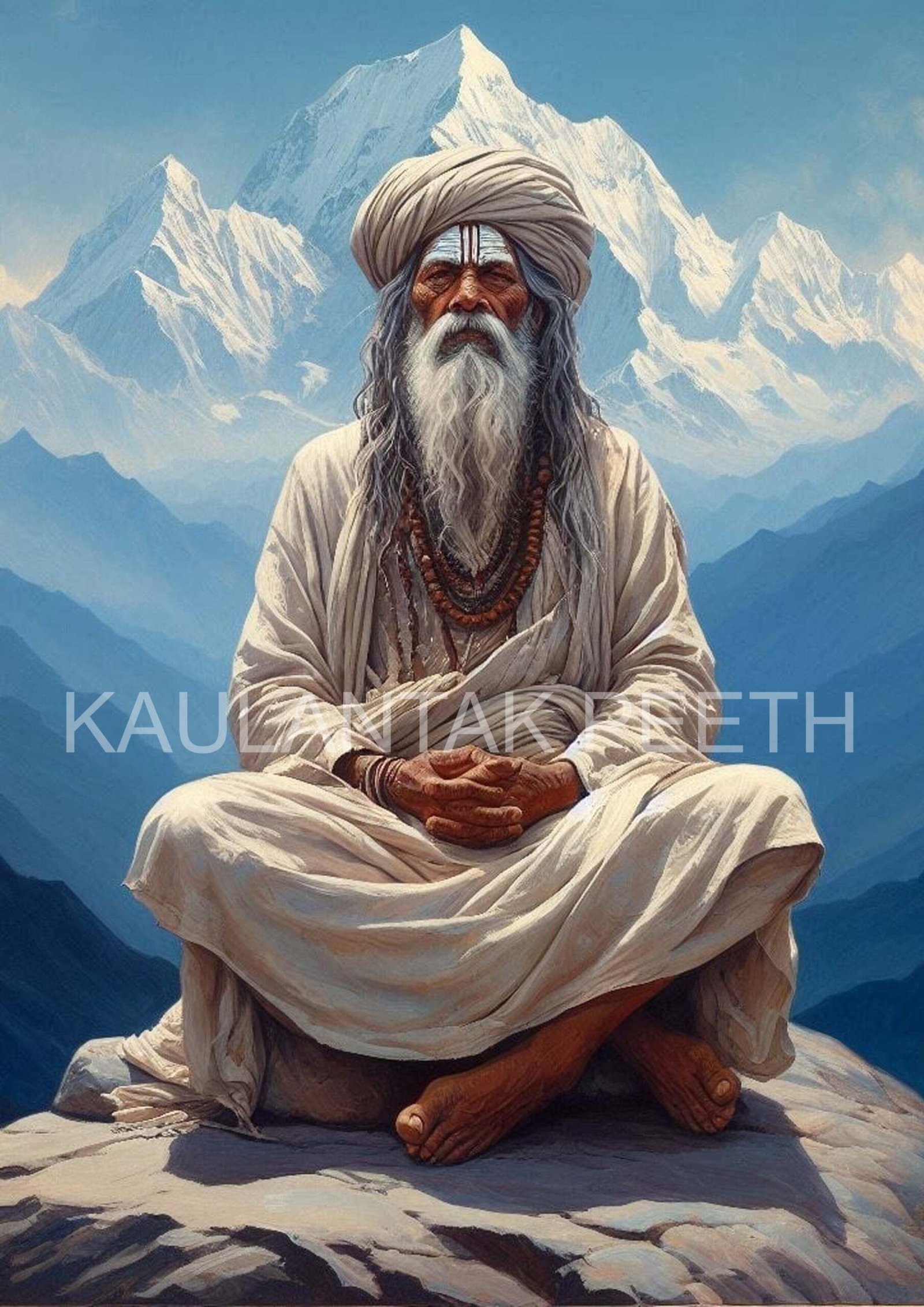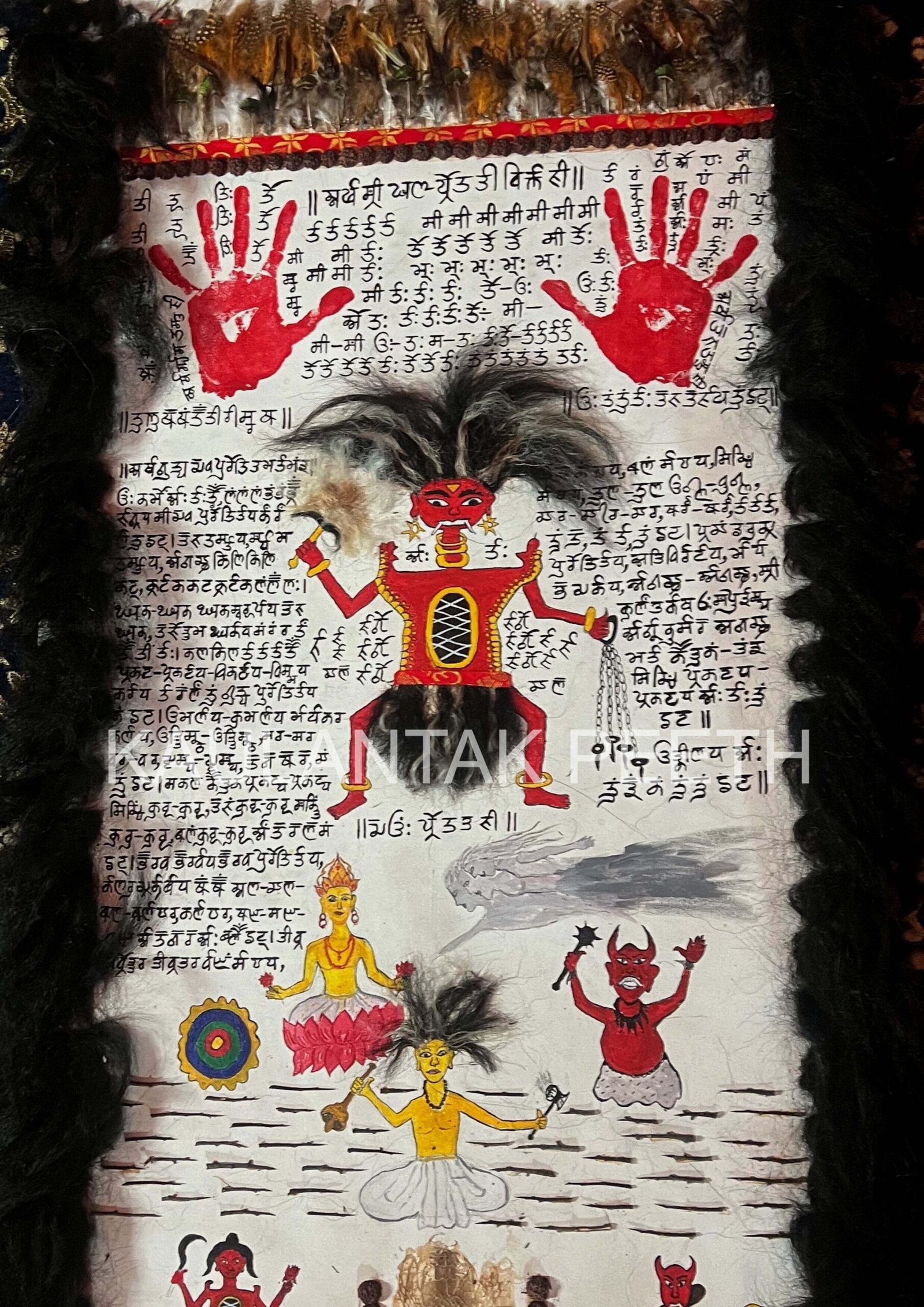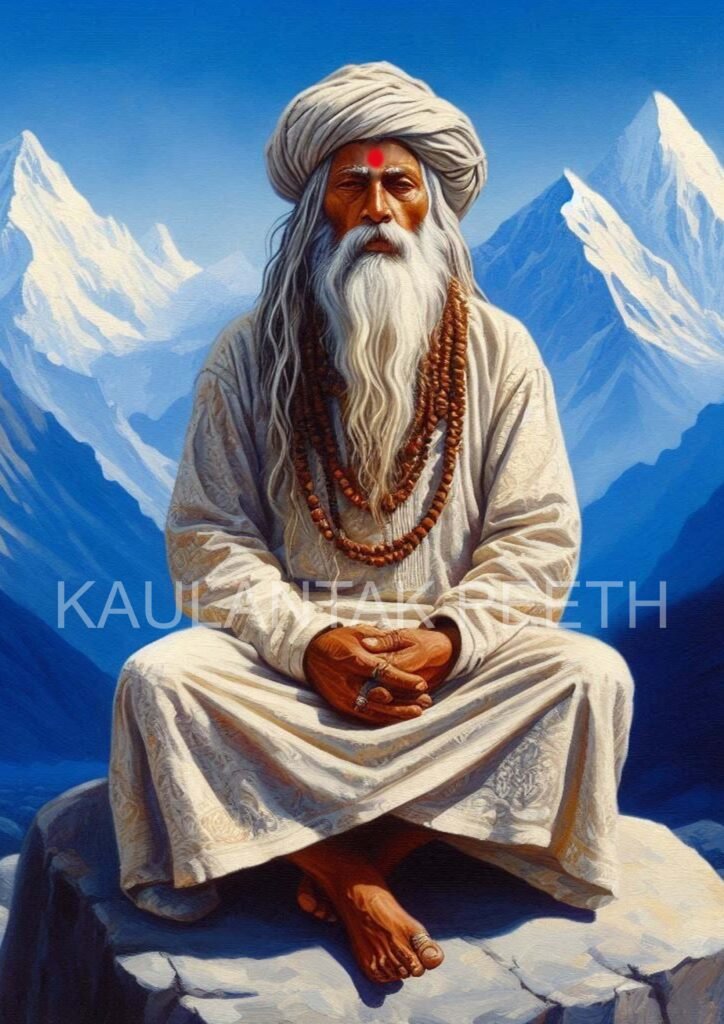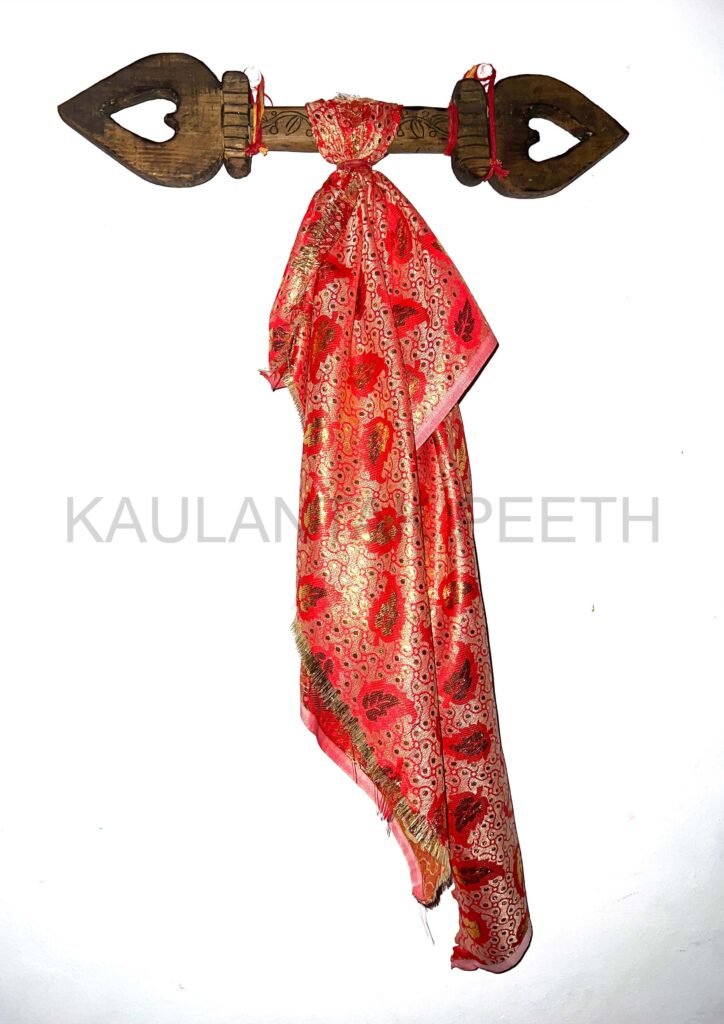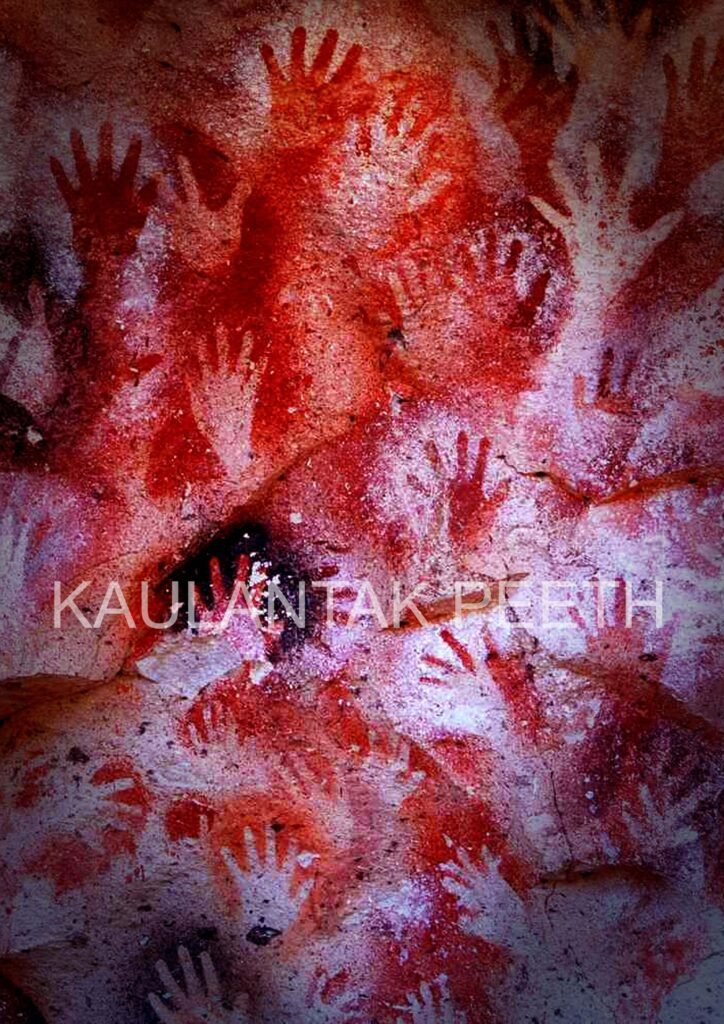Introduction
Shamanism, practiced globally, involves shamans connecting with subtle realms through altered states of consciousness or trance. In the Himalayas, this practice is known as Ghaṇa Puruhiti Vidyā (घण पुरोहिति विद्या). The term ‘Ghaṇa’ (घण) is derived from ‘Ghana’, meaning ‘cloud’ in an indigenous context. ‘Purohiti’ (पुरोहिति) refers to a priest or one who conducts religious rituals and ceremonies, while ‘Vidyā’ (विद्या) means knowledge or science. Thus, Ghaṇa Puruhiti Vidyā translates to “the science of the priest of the cloud.”
In this tradition, practitioners worship and conduct rituals dedicated to Deva Purohita, a revered Shiva Gaṇa who serves as the priest for all Shiva Gaṇas. Originally known as Nāgamaya, Deva Purohita is central to the practices of these Himalayan shamans, who may also be referred to as ojha, gur, or jhakri.
According to Siddha Dharma, Himalayan shamans follow the traditions of Shiva and Shakti, engaging deeply with the spirit world. These shamans serve as healers, curing diseases and conducting various rituals. They possess skills in divination, guidance, Ayurveda, herbalism, and elements of alchemy (rasāyana), as well as in astrology (jyotish). Their roles also include acting as mediums, facilitating communication between humans and various entities such as devī (goddesses), devtā (gods), and spirits including bhūt, preta, dānava, and ancestors.
Within this rich tradition, there are other types of shamans known as Gur, who typically connect with a specific deity or spirit. Unlike the Gur, a practitioner of Deva Purohiti Vidyā can mediate between humans and a wide array of divine and spiritual beings, including ancestral spirits and other yonis (realms of existence).
Learning Ghaṇa Purohiti Vidyā is a rigorous and practical endeavor, requiring apprenticeship under a knowledgeable guru. Aspiring shamans must master various esoteric and practical skills including alchemy, astrology, the use of mantras, yantras, and ṭoṭakā (magical rituals). Training also encompasses the arts such as music and dance, which are integral to shamanic rituals. Understanding the nuances of vocal tones and sound production is crucial, as is learning to navigate interactions with men, women, and children according to specific protocols.
Ghaṇa Purohiti vidyā is the basic fundamental vidyā in shamanism. There are no books. It is primarily an oral tradition. It is usually taught in different sections. Sometimes scrolls are created to teach this vidyā. And sometimes the secrets of himalayan shamanism are taught by writing or drawing on mud or stone.
In Siddha tradition of himalaya , hiamalayan shamanism or Ghaṇa Puruhiti Vidyā is divided in two parts- Krishṇa Purohita and Shukla Purohita. Krishṇa Purohita focuses on tantra aspect and perform dark magic rituals while Shukla Purohita are mediums and gur or shaman of devī devtā.
As per Maha Siddha Ishaputra, himalayan shamanism is called ghaṇa purohiti vidyā also because the shaman meditates and visualize an electric illumininated iridiscent orb or cloud. It is refered to as cloud because it does not have a fixed form and changes its shape and size much like a cloud. By meditating on this cloud, shamans accomplish their work which could involve communicating with devi, devta or other beings and even to gain healing power from it. This iridescent cloud acts a a portal for the shaman. The vidyā of himalayan shaman is connected with this divine cloud. Practitioner of ghaṇa purohiti vidyā worships, meditates, visualize and connect with this divine iridescent cloud.
Hasta Cinha or Symbol
Upon entering the practice of Ghaṇa Puruhiti Vidyā, initiates begin by creating a symbolic impression of a part of their body. This ritual, performed on a purified surface, involves using kumkum or another red pigment to mark the chosen body part, which is then pressed against a medium such as stone, cloth, paper, or more traditionally, bhojapatra or papyrus bark—materials revered in tantra for crafting yantras.
This imprint, known as a cinha, serves as a personal and spiritual symbol of the practitioner’s commitment to the path. Depending on the ritual’s requirements, the cinha may be preserved in a sacred space, burned, or offered to a river. Commonly, if the imprint is of the palm, it is referred to as Hasta Cinha. However, it is not restricted to the palm; impressions of feet, the tongue, ears, forehead, or even the nose are also used, reflecting the individual shaman’s unique approach.
This symbolic offering is made to the custodian of the Deva Purohiti Vidyā, the Deva Purohita, marking the practitioner’s initiation into the vidyā. An interesting belief within the tradition is that an adept shaman, on a solitary journey in the Himalayas, may discover a kumkum palm imprint mysteriously appearing on their back—an area unreachable by one’s own hand. This mark is seen as a divine acknowledgment of the shaman’s mastery and the acceptance of their accomplishments by Deva Purohita.
The practice of creating a cinha not only marks the beginning of a shaman’s journey in Ghaṇa Puruhiti Vidyā but also resonates with ancient global shamanic traditions, where symbols of hands and fingers are commonly found on cave walls, symbolizing connection and continuity with the spiritual world.
Ghana Dhyāna
At the core of Ghaṇa Puruhiti Vidyā lies the practice of Ghana Dhyāna, or meditation on the divine cloud. This technique involves the shaman either sitting or lying down to focus on a vivid, spherical orb of light that continuously shifts shape, much like a cloud. This radiant orb, which does not maintain a fixed spherical form, displays an array of colors, symbolizing its dynamic and ephemeral nature.
Shamans believe that this divine cloud is the source from which the world manifests and ultimately returns. Guarded by a deity known as Deva Purohita, the cloud serves as a metaphysical gateway. During meditation, if a shaman seeks knowledge, healing, or specific outcomes, they communicate through Deva Purohita, who, in turn, slightly opens the gateway of the cloud to grant the desired results.
The cloud is said to appear in twelve, and in some traditions, twenty-one distinct colors, each meditated upon for its unique spiritual properties. Additionally, during Ghana Dhyāna, the form of Deva Purohita is visualized within this cloud. He is depicted wielding a chanwar (ceremonial whisk) in one hand and a shangal (a ritual tool fashioned from an iron chain) in the other. His attire includes a skirt-like wraparound made from hair, complementing his fierce appearance characterized by vyāgra dant—two prominent fangs—and thorn-made earrings known as kunḍala.
For established shamans, the practice of Ghana Dhyāna is not bound by specific times. However, for those still mastering their skills, the preferred times for this meditation are during the dusky hours of evening and on the nights of Sunday, Tuesday, Thursday, and Saturday.
The practice of Ghana Dhyāna is intricately linked with specific yantras and mantras, integral to channeling the desired spiritual energies. To embark on this profound meditative journey, an aspiring shaman must be initiated and empowered by an elder practitioner, ensuring the transmission of this sacred knowledge is both respected and preserved.
Vidhi
The foundational practice in Ghaṇa Puruhiti Vidyā is meditation on the divine cloud. This initial step involves the shaman focusing on a transcendent, formless supreme truth known as nirguna brahma, perceived as the creator of the divine cloud, the universe, and all within it. For shamans, nirguna brahma represents the ultimate source of divinity.
Following this profound meditation, the practice transitions to saguna dhyāna, focusing on Deva Purohita. Here, the shaman engages in a directed visualization, praising and praying to Deva Purohita. The intention is for Deva Purohita to guide the divine cloud towards a specific deity, opening a portal that allows the energies of that deity to reach the shaman. This method is employed whether connecting with divine entities such as devī or devtā, or other realms (itar yoni) like those of spirits (bhūta, preta) or demons (dānava).
In the world of Himalayan shamanism, nothing is accomplished without the intermediation of Deva Purohita.
Shamans also adhere to unique personal practices to deepen their spiritual connection. One such practice is never cutting their hair, which is dedicated to Deva Purohita. This overgrown hair plays a crucial role during rituals, helping the shaman enter a trance state by draping it over the face to mimic being enshrouded by a dense cloud.
Additionally, specific pranayama techniques are integral to shamanic practice, teaching control over breath to help facilitate the transition into trance states. Mastery of these breathing patterns is essential for the shaman, known variously as ojhā or gur, to excel in their spiritual endeavors.
Sound also plays a pivotal role in the rituals. Shamans utilize bīja mantra dhvani or seed sound syllables, which may be Vedic, akula (non-traditional), or vikrit (altered). Globally, shamans are known to produce distinct sounds during trance states, often mimicking natural noises through onomatopoeia, with elongated syllables such as “hā”, “he”, or “ho” serving specific ritualistic functions.
Moreover, shamans employ diverse physical methods to induce trance states. These can range from self-flagellation with iron instruments, needle piercing, and walking on fire, to consuming non-traditional substances like wheat flour or mud. Others may drink water, inhale the smoke of specific herbs or incense from a dhumra pātra (smoking vessel), or use auditory stimuli like ringing bells or playing instruments to achieve the desired state of trance.
Tri Deva of Shamans
Shamans in Himalayan tradition connect with three types of divinities, classified based on their natural domains: jalacara (water-dwelling), thala cara (land-dwelling), and nabhacara (sky-dwelling). Each type of divinity is associated with specific portals—smaller versions of the divine cloud or ghana—located in water, on land, and in the sky. These portals, guarded by Deva Purohita, serve as gateways to the realms of the respective divinities.
Shamans recognize that diverse spirits and deities inhabit different natural features, such as lakes, rivers, waterfalls, and forests. For example, a river might be the domain of entities like yoginis, dākinīs, shākinīs, or kinnari. Through the portals associated with these natural features, shamans engage with the presiding deities to seek blessings or assistance for community needs such as peace, wisdom, purification, healing, or exorcism.
Ghana, the primary divine cloud, functions as the major conduit for significant shamanic work, but shamans also connect with numerous smaller ghana scattered across various regions. These connections are facilitated even when the shaman may not know the names of the deities but can intuit their nature—whether sattvic (pure), rajasic (dynamic), or tamasic (dark). This intuition helps the shaman decide on appropriate offerings or rituals, like bali (sacrifice), to align with the deity’s disposition for specific outcomes.
In states of trance, shamans utilize these portals to connect with a wide array of entities, extending beyond natural spirits to include deities enshrined in temples, or even murtis (idols), which themselves can become conduits. Similarly, symbols associated with the deities or sacred objects can serve as additional portals. Through these connections, shamans can also communicate with human ancestors or other spirits, assisting those who seek guidance or closure.
Furthermore, shamans are sometimes called upon to deal with negative influences from entities like dānavas (demons) or other dark beings. Individuals possessed by such energies may exhibit drastically altered behaviors, including self-harm or withdrawal from society. In extreme cases, these possessed individuals might display disturbing actions such as locking themselves in dark spaces or engaging in harmful practices. In these situations, shamans work to restore balance and guide the afflicted back towards health and societal reintegration.
Himalayan Shaman
Across the diverse regions of the Himalayas, a shaman may be known by various titles such as gur, jhakri, or other local terms. The path to becoming a shaman typically begins with an aspirant approaching an established shaman to request training. This mentorship often involves the apprentice living with the shaman, engaging in active observation—an essential part of the learning process.
In this apprenticeship, the shaman imparts knowledge about various deities (devī and devtā) and other spiritual entities from different realms (itar yoni). The transmission of shamanic knowledge (vidyā) varies widely as each shaman has their unique methods and rituals. Despite this variety, all techniques collectively adhere to the principles of Ghaṇa Purohiti Vidyā.
Shamans utilize sacred musical instruments as part of their practice and teach their students how to use them. They also introduce the use of dhumra patra, a vessel for burning specific herbs and incenses, alongside various mantras. A crucial aspect of shamanic training is fostering a distinct identity within the community. This self-differentiation, akin to self-hypnosis, helps maintain the shaman’s spiritual and societal role. Failure to uphold these distinct practices can lead to a dilution of their spiritual powers.
To preserve their unique identity and purity, shamans adopt specific dietary habits, dress codes, and lifestyle choices. Common attire might include turbans or other head coverings, and they may also wear symbols such as animal claws, specific lockets, or yantras related to their deities.
Himalayan shamans are known to cover their heads with turbans or hats and utilize various tools like dice for divination and communication with spiritual entities. Their arsenal may include bells, damaru (drum), and other tantra musical instruments, as well as dhuni patra or other vessels for herbal smoke, which are essential in their rituals.
Aspiring shamans must adhere closely to the traditions of their mentors, which can include specific protocols around eating habits, clothing, and other daily practices. These traditions vary significantly across different regions, reflecting the rich diversity within Himalayan shamanistic practices.
Transfer of Shamanic Shakti
The transmission of shamanic power, or shakti, from a senior shaman to a student is a pivotal moment in the student’s spiritual journey. This transfer can be facilitated through various sacred objects that hold spiritual significance, such as animals, birds, feathers, trees, leaves, or personal artifacts like a staff, necklace, turban, jewel, or metallic tool.
In the Himalayan Siddha tradition, historically, the process involved the creation of a sacred scroll. This scroll was crafted by stitching together goat leather and embellishing it with materials such as yak hairs, rudraksha beads, jewels, bird feathers, and various animal parts like porcupine quills. The master shaman would perform rituals over this scroll and guide the student in making a similar artifact. The transmission of shakti occurred when the master touched his scroll to that of the student’s, accompanied by mantra empowerment and the sprinkling of wheat flour, symbolically passing on the shamanic power.
However, significant changes have been instituted by Maha Siddha Ishaputra, the head of Kaulantak Peeth, reflecting a shift towards more ethical practices. Recognizing the need for compassion and sustainability, Ishaputra banned practices involving harm to animals, such as skinning them for scrolls. Modern scrolls are now made using non-invasive methods—collecting yak hair without harming the animal, using naturally shed bird feathers found in forests, and employing rudraksha seeds or shaigul thorns. These scrolls are crafted without causing harm to any creatures and are embellished with precious stones like diamonds to enhance their spiritual potency.
The updated scrolls, which continue to serve as fundamental tools in the transmission of shamanic shakti within the Siddha tradition, are preserved in the Siddha library of Kaulantak Peeth, serving as both sacred artifacts and historical records of the evolving practices within Himalayan shamanism.
Ghaṇa Purohiti Vidyā Scroll
The Ghaṇa Purohiti Vidyā encompasses four key aspects, detailed in both oral traditions and inscribed on sacred scrolls as directed by master shamans. Each element represents a specific facet of shamanic wisdom and practice:
Bhāva Yantra
These are intricate yantras crafted to evoke specific emotional states (bhāv) essential for shamanic practices. They facilitate the purification of the mind and intellect and are used to cleanse the inner consciousness (antahkaran). Bhāva Yantra is not limited to sacred geometry; it can also encompass natural elements like trees or objects such as diamonds. The master shaman instructs the apprentice on how to visualize and utilize these yantras effectively.
Vādya Yantra or Pracanḍa Shastra
This part of the scroll includes depictions of deities (devī and devtā) and prescribes the use of sacred musical instruments (vādya yantra) and weapons (astra sastra). These items are integral to the ritual practices outlined in the scroll, aiding shamans in their spiritual endeavors.
Sanketa Lipi
Shamans employ various symbols and sign languages to create yantras for healing, purification, divine invocation, and magical rituals. These symbols can include figures, shapes, or sets of numbers. They are applied in diverse ways, such as drawing on the body of a person seeking healing or integrating them into offerings like water.
Tantra Kilaka and Kula Srota
In Kaulantak Peeth, shamanic rituals (kriyā) are conducted using the Kula Srota, a ritual implement adorned with the Kurukulla kaṃ bīja on both ends. This tool is essential for all invocations and ceremonies. For controlling or confining negative energies, specific tantra kilakas such as knives or the Kulānkusha (considered more potent than a vajra) are used. These kilakas vary according to the entities involved, such as mahāvidyās, yoginis, vīra, and bhairava. In instances of negativity, a shaman might take a piece of clothing from the affected individual, pierce it with the kilak, and bury it to mitigate the negative influence.
These elements collectively form the foundational texts and tools of Ghaṇa Purohiti Vidyā, guiding shamans in their spiritual practices and interactions with both benevolent and malevolent forces. This refined section aims to clearly articulate the diverse components and their significance within the broader shamanic framework of the Himalayas.

